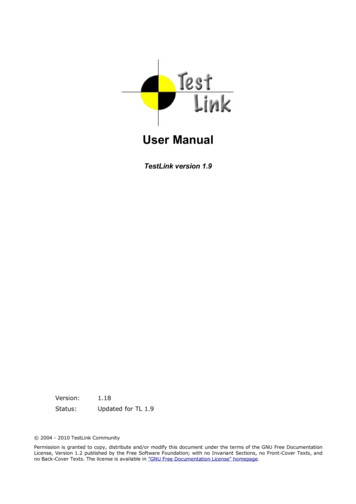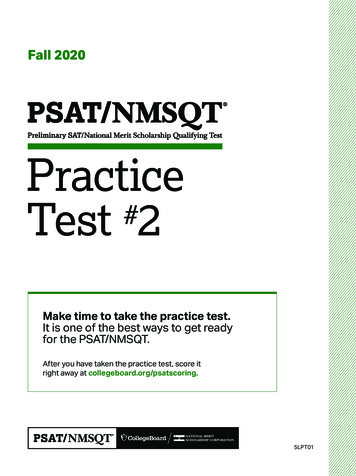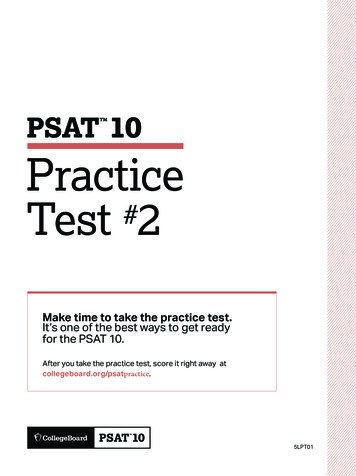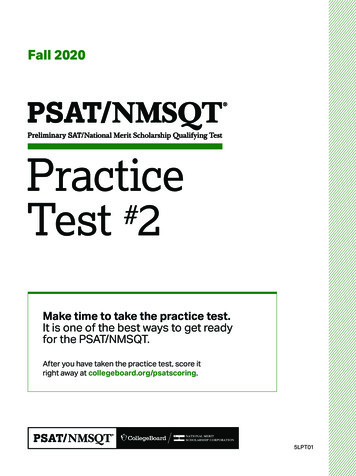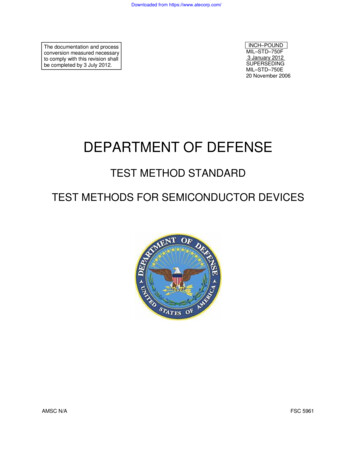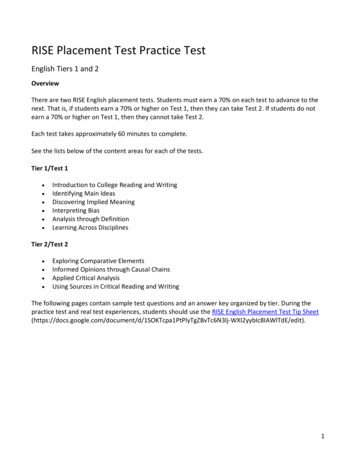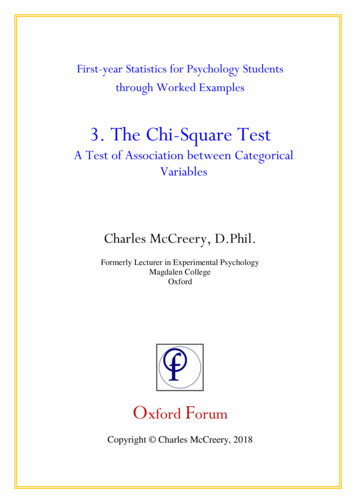
Transcription
First-year Statistics for Psychology Studentsthrough Worked Examples3. The Chi-Square TestA Test of Association between CategoricalVariablesCharles McCreery, D.Phil.Formerly Lecturer in Experimental PsychologyMagdalen CollegeOxfordOxford ForumCopyright Charles McCreery, 2018
AcknowledgementsI am grateful to the following for comments and guidance at variouspoints in the evolution of this tutorial: Dr Fabian Wadel, Dr PaulGriffiths, and Professor David Popplewell.I am also indebted to Andrew Legge for help with the formatting ofmathematical formulae and symbols.Most recently, I have become much indebted to Dr Ed Knorr, who verykindly read through the complete typescript and made numeroussuggestions and corrections, both large and small.Any remaining errors or omissions are my responsibility. I would bepleased to receive information from anyone who spots any error,mathematical or otherwise. I can be contacted via e-mail at:charles.mccreery@oxford-forum.orgI should also be pleased to hear from anyone who finds this tutorialhelpful, either for themselves or for their students.Charles McCreery2
Introduction1There are usually three complementary methods for mastering any newintellectual or artistic task; these are, in ascending order of importance: reading books about it observing how other people do it actually doing it oneselfThese tutorials focus on the second of these methods. They are basedon handouts that I developed when teaching first-year psychologystudents at Magdalen College, Oxford. The core of each tutorial is aworked example from an Oxford University Prelims Statisticsexamination paper. I have therefore placed this section in prime position;however, in teaching the order of events was different, and more nearlycorresponded to the three-fold hierarchy of methods given above:1. Students were invited to read one of the chapters on theRecommended Reading list, given at the end of each tutorial. Theywere also expected to attend a lecture on the topic in question atthe Department of Experimental Psychology.2. Students would attend a tutorial, in which we would go throughthe worked example shown here. They would take away thehandouts printed as Appendices at the end of each chapter, whichwere designed to give structure to the topic and help them whendoing an example on their own.3. They would be given another previous examination question totake away and do in their own time, which would be handed inlater for marking.I am strongly in favour of detailed worked examples; following one isthe next best thing to attempting a question oneself. Even better thaneither method is doing a statistical test on data which one has collectedoneself, and which therefore has some personal significance to one, butthat is not usually practicable in a first-year course.1This is a general introduction to the series of six tutorials available l3
I list three books in the General Bibliography at the end of this manualwhich give worked examples. One of these is Spiegel (1992), in whicheach chapter has numerous ‘solved problems’ on the topic in question.These worked problems occupy more than half of each chapter. However,the solutions to the individual problems are not as detailed and discursiveas the ones I give here.Another book which is based on worked examples on each of thetopics covered is Greene and D’Oliveira (1982), also listed in the GeneralBibliography. Their examples are as detailed as those I give here.However, they do not cover probability and Bayes’ theorem or Analysisof Variance.Finally, I strongly recommend the Introductory Statistics Guide byMarija Norusis, designed to accompany the statistical package SPSS-X,and based on worked examples throughout. Even if the student does nothave access to a computer with the SPSS-X package on it, this instructionmanual contains excellent expositions of all the basic statistical conceptsdealt with in my own examples.4
The Chi-Square TestA Test of Association between Categorical VariablesContents1The question2The answer2.1 How to recognize that this a chi-square question2.2 Method2.3 Plot of class and development2.4 Calculation2.5 Further analysis2.6 Explanation for the two differing conclusions2.7 The nature of the relationship observed in the second test3Summary of steps in a chi-square test4Recommended readingAppendix 1: Summary of some key points about the chi-square testAppendix 2: How to recognize what type of test to doGeneral Bibliography5
1. The question2Neyzi, Alp and Orhon (1975) investigated the effect of socio-economic class onphysical development of Turkish children. Physical development was classifiedon a scale of 1 (none) to 5 (fully developed) and the socio-economic class oftheir parents was assessed on a scale of 1 (highest) to 4 (lowest).The data were as follows:Physical developmentSocio-economicclass of lot these data in a meaningful way and report your initial findings.Stating clearly your hypotheses, carry out an analysis to test for a relationshipbetween physical development and socio-economic class using as manydifferent categories of physical development as possible, and report yourconclusions.Carry out a further analysis comparing those who are fully developed (stage 5)with those who are not (stages 1-4) and report your conclusion.Provide an explanation for these two conclusions.For any test where you detect a relationship, report on the nature of thatrelationship.2The question is taken from the Preliminary Statistics paper for first-year psychology studentsat Oxford University, Hilary Term, 1999.6
2. The answer:[2.1 How to recognise that this is a chi-square question:The layout of the data may look superficially like that of a two-wayANOVA, but the data in the cells are raw numbers; to be an ANOVA theentries in the cells would have to be means.Note also that the measures are both categorical. Class is an ordinal,not an interval, measure. (See Appendix 2 for some points on thisdistinction.) Physical development might have been a continuous, intervalmeasure, but here it is not; the five categories are discrete and we do nothave any information about how they are arrived at, so we can only safelyconclude that they are ordinal.]2.2 MethodThe first thing we have to do is collapse some cells. A requirementof the chi-square test is that there should be at least 5 observations in eachcell. (The wording of the question contains a hint to remember this whenit says ‘using as many categories of physical development as possible’ inparagraph 4.) We therefore amalgamate columns 1 and 2, and columns 4and 5, to give the following:Physical 97
2.3 Plot of class and development[There are two possible ways of plotting this data: as a stacked barchart of percentages, or as a line chart. The former is sometimes morerevealing, but takes much longer. I recommend a line chart in this case. Infact I recommend line charts for all questions in this paper except thosewhich require you to plot a frequency distribution. The DescriptiveStatistics type of question has in the past always required a bar chart, andoccasionally there are other types of questions which require you to plot afrequency distribution, such as the goodness-of-fit question from HilaryTerm 1999.]The plot (see page 11) reveals that in all classes except Class 3 thenumber of subjects increases as physical development increases. This ispresumably a function of how the population was sampled (i.e., there wasa disproportionate number of older children in the sample). The reason forClass 3 not showing this pattern may simply be a chance effect of the totalnumber in this class being smaller than in any of the others.The most notable effect revealed by the plot is that fully developedchildren are apparently over-represented in Class 1. This suggests thehypothesis that children in this class develop faster than those in othersocial classes.The question does not reveal how socio-economic status wasdetermined, but in the United Kingdom the ordinal value of the classes isnegatively correlated with socio-economic status, at least as defined bythe commonly used criteria of the Office of Population Censuses andSurvey’s Classification of Occupations and Coding Index. (I.e., Class 1has the highest rank, and includes professions such as lawyers anddoctors; the lowest rank is Class 5, and includes unskilled manualworkers).If we assume that this or a similar classification was used in theNeyzi, Alp and Orhon study, we might hypothesize that the effects foundwere due to better nutrition, for example, or better living conditionsgenerally.8
Plot of Socio-Economic Class and Physical Development70605040Class 1Class 2Class 3Class 4Number of children30201001-234-5Physical development 2.4 CalculationThe next step is to compute the row and column totals, thus:Physical 39423343996Totals7499145318Class9
Next we have to compute the expected value for each cell, using theformula:(Row total / Grand total) x Column totale.g., for the first cell of Row 1 (Class 1, Physical development 2):(Row 1 total / Grand total) x Column 1 total 102/318 74 0.32 74 23.74 24 rounded to the nearest whole number.[See Hoel (1976) p. 253 for a good explanation of why this methodgives you the expected values (see ‘4. Recommended Reading’ below).]The resulting table is as follows (expected values are inparentheses):Physical development1-234-5TotalsClass116 (24)28 (32)58 (46)102222 (19)25 (25)34 (37)8313 (9)12 (12)14 (18)39423 (22)34 (30)39 (44)96Totals7499145318Now we have to apply the formula for the chi-square statistic:χ2 [(O - E)2 / E]where O the observed frequency in each categoryE the expected frequency in each categoryand the summation is made over all categories.10
In this case this gives:χ2 (16 24)2/24 (22 19)2/19 (13 9)2/9 (23 22)2/22 (28 32)2/32 (25 25)2/25 (12 12)2/12 (34 30)2/30 (58 46)2/46 (34 37)2/37 (14 18)2/18 (39 44)2/44 2.67 0.50 3.13 0.47 0 0.24 1.78 0 0.89 0.05 0.53 0.57 10.83Degrees of freedom (No. of rows l)(No. of columns 1) (4 1)(3 1) 6For the test to be significant at the 0.05 level, given 6 degrees offreedom, the value for χ2 has to be at least 12.59 (see Table VII on page336 of Hoel, 1976, for example). Therefore we cannot reject the nullhypothesis of no association between the two variables: parents’ socioeconomic class and physical development.Conclusion: any effect in Class 1 as revealed by the plot isswamped by the lack of any effect elsewhere.2.5 Further analysisAmalgamating physical development stages 1-4, and recomputingthe expected values for each of the new cells by the method describedabove, gives us the following contingency table:Physical (35)90(85)28318(11)9(9)2(4)6(11)3510281399631811
Applying the formula:χ2 [(O-E)2 / E] (84-91)2/91 (18-11)2/11 (72-72)2/72 (9-9)2/9 (37-35)2/35 (2-4)2/4 (90-85)2/85 (6-11)2/11 0.538 4.454 0 0 0.114 1 0.294 2.27 8.67d.f. (No. of rows l)(No. of columns 1) 3 1 3From a table of the χ2 distribution (e.g., Table VII on p. 336 ofHoel, 1976), the critical values for χ2 with 3 degrees of freedom are 7.81at the 0.05 level and 11.34 at the 0.01 level. In the present case, 0.01 p 0.05 (i.e., our result is significant at the 1 in 20 level).Conclusion from the test: there appears to be a relationship betweenthe socio-economic status of the parents and the physical development ofthe children. We reject the null hypothesis of no relationship, at the 1 in20 level.2.6 Explanation for the two differing conclusionsReducing the number of cells in the second version of the testreduces the number of degrees of freedom, and hence the size of the χ2value required to achieve significance. In other words we have givenourselves fewer opportunities to pick up discrepancies between observedand expected frequencies, and so the chances of such deviations arisingfortuitously are correspondingly diminished.We may also think of the difference between the two tests asfollows: by amalgamating the first four categories of physicaldevelopment we have counteracted the effect mentioned above, namelythat the overrepresentation of Class 1 children in the highest category ofphysical development and the underrepresentation of Class 4 children inthat same category was swamped by the lack of any deviation fromexpected values elsewhere in the table.12
2.7 The nature of the relationship observed in the second testThere appears to be a positive association between physicaldevelopment and parental socio-economic status. This effect is mainlyexpressed at the upper and lower extremes of the range, i.e., in Classes 1and 4. The effect is only apparent when physical development has reachedits fullest potential.[N.B. (1) To fulfil the instructions for the second test we have hadto violate the requirement of at least 5 observations in each cell, thusillustrating that this is a practical desideratum, rather than an absolutenumerical prerequisite. One might comment on the fact that thisrequirement had been violated in answering the question, pointing out thatany such violation is liable to reduce the validity of the test.N.B. (2) The format of this question— asking you to do one chisquare test, then collapse some cells and do another to compare with thefirst—is characteristic of the chi-square questions that have appeared inthe Oxford Psychology Prelims Statistics paper of recent years.]13
3. Summary of steps in a chi-square test Where expected values are not known:1. Draw up a contingency table of the observed values.2. (a) Compute the column totals. (b) Compute the row totals3. Assume the null hypothesis of no association between thetwo variables and work out the expected value for each cellunder this hypothesis from the row and column totals. (Thisis done by applying the formula: Row total/grand total xcolumn total.)4. Compute the value of chi-square statistic from the formula:χ2 [(O-E)2 / E].5. Work out the degrees of freedom:d.f. (No. of rows l) (No. of columns 1).6. Look up the relevant critical value of p in a table of the χ2distribution (e.g., in Hoel, 1976, p. 336). To test goodness-of-fit against known expected values:1. Draw up a table with the following rows:(a) The possible values of x (the variable we are interested in)(b) The observed frequency for each value (O)(c) The expected frequency for each value (E)(d) (O-E)2 for each value(e) (O-E)2 / E for each value2. Apply the chi-square formula (χ2 [(O-E)2 / E]) as for atest where the E’s are not known.14
4. Recommended reading:a. Hoel, Paul G. (1976). Elementary Statistics (4th edition). New York:Wiley. Chapter 10.b. OR: Spiegel, Murray R. (1992). Schaum’s Outline of Theory andProblems of Statistics (2nd edition). New York: McGraw-Hill.Chapter 12.c. OR: Howell, David C. (1997). Statistical Methods for Psychology(4th edition). London: Duxbury Press. Chapter 6.I recommend Hoel (1976) for this topic. It is quite short, but coversall you need to know about the chi-square test for the Oxford Prelimsstatistics course. Spiegel also covers the ground, but is rathercondensed as usual, with a minimum of discursive discussion.Howell contains considerably more than you need to know. I do notrecommend Hays3 for this topic; it also contains more theory thanyou need.Hays, William L. (1994). Statistics (5th edition). Orlando, Florida: Harcourt Brace.This is a book sometimes recommended in connection with the Oxford first-yearstatistics course.315
Appendix 1Summary of some key points about the chi-square test Suitable for categorical data:i.e., data that can be derived from a merely nominal measure (e.g.,gender), though ordinal measures are also suitable. Key concept:‘contingency table’ Practical desideratum:at least 5 observations per cell Two sorts of application:1. where expected values for cells are known (e.g., ‘goodness-offit’ tests)2. where expected values are not known (and therefore have to beworked out from the observed data, as in the example above) Yates’s correction:Subtract 0.5 from each of the ‘(OE)’ terms, before squaring,on the top line of the formula (see Section 3, above: ‘Steps’).N.B. Yates’s correction only applies when (a) dealing with atwo-by-two table, and (b) when the numbers are small. If indoubt, apply the formula with and without the correction andquote both results, commenting on any difference. (The χ2 valueafter the correction should always be smaller.)16
Appendix 2How to recognise what type of test to doType ofmeasureNature of dataExamplesSuitable testsNominalDiscontinuous/categorical,having no regard for alDiscontinuous, but rankorderedSocial classExtraversionNon-parametric,e.g., Chi-square.Parametric ifplenty of ranksand normallydistributed dataIntervalTruly quantitative andcontinuous, so intervalsall equal; but zero ruly quantitative andcontinuous; intervalsequal, and zero point notarbitrary, so, for example,a doubling of the measureobtained implies adoubling of theunderlying quantitymeasuredKelvinAgeWeightHeightParametric17
General BibliographyTextbooks of the kind listed below are usually updated every few years. Ifthe reader finds there is an edition later than the one listed here, he or sheis recommended to buy the latest version.Greene, Judith and D’Oliveira, Manuela (1982). Learning to UseStatistical Tests in Psychology. Milton Keynes: Open University Press.Hays, William L. (1994). Statistics (5th edition). Orlando, Florida:Harcourt Brace.Hoel, Paul G. (1976). Elementary Statistics (4th edition). New York:Wiley.Howell, David C. (1997). Statistical Methods for Psychology (4th edition).London: Duxbury Press.Norusis, Marija J. (1988). SPSS-X Introductory Statistics Guide, for SPSSX Release 3. Chicago, Illinois: SPSS Inc.Spiegel, Murray R. (1992). Schaum’s Outline of Theory and Problems ofStatistics (2nd edition). New York: McGraw-Hill.Tabachnick, Barbara G. and Fidell, Linda S. (1983). Using MultivariateStatistics. London: Pearson Education Ltd.18
Charles McCreery is a Research Director at Oxford Forum, anindependent association of academics, set up to research and publish incurrently neglected areas of psychology, theoretical physics, philosophyand economics.If you feel have derived some benefit from this tutorial, please considermaking a donation to Oxford Forum’s work, via the PayPal button on thefollowing webpage:https://celiagreen.blogspot.co.uk/Some other publications by members of Oxford Forum are described inthe following pages. They are available from Amazon UK and AmazonUSA.19
Celia GreenLucid DreamsForeword by Professor H.H. Price, FBAThe original pioneering study of lucid dreams: dreams in which thesubject is aware that he or she is dreaming, and sometimes able tocontrol the course of the dream.“A fascinating subject together with a wealth of equally fascinatingexamples.”J.B. Priestley“the author should be congratulated on her choice and treatment ofa subject on which so very little previous work has been done.”Times Literary Supplement“This fascinating book raises interesting questions which willdoubtless form the basis of experimentation.”Professor W.H Sprott, The Listener“[Lucid dream research] rests almost entirely on the meticulousdescriptions and classifications of types and subtypes put forward byGreen in her initial publications . All of us ‘second generation’researchers have found ourselves continuously in her debt.”Professor Harry Hunt, Brock UniversityHamish Hamilton, reissued by Institute of PsychophysicalResearchISBN 978 09000760 08 (hardback)20
Charles McCreeryDreams and PsychosisA new look at an old hypothesisThis paper proposes a theory of psychosis based on a link between sleepand hyperarousal. It is argued that the phenomenological similaritiesbetween psychosis and dreams arise from the fact that sleep can occur,not only in states of deafferentation and low arousal, but also in states ofhyperarousal resulting from extreme stress.It is proposed that both schizophrenic and manic-depressive patients arepeople who are prone to episodes of hyperarousal. Various sorts ofelectrophysiological evidence are adduced for this proposition, drawn fromthe fields of electroencephalography, studies of the galvanic skin responseand studies of smooth pursuit eye movements. In addition, it is suggestedthat a key finding is the apparently paradoxical one that catatonic patientscan be aroused from their seeming stupor by the administration ofsedatives rather than stimulants.It is proposed that a tendency to hyperarousal leaves certain individualsvulnerable to ‘micro-sleeps’ in everyday life, with the attendantphenomena of hallucination and other sorts of reality-distortion. Delusionalthinking may follow as an attempt to rationalise these intrusions of dreamphenomena into daylight hours.Oxford ForumPrice 4.95; 34 pagesISBN 978 09536772 8321
Celia GreenOut-of-the-Body ExperiencesForeword by Professor H.H. Price, FBAAn analysis of four hundred first-hand case histories in which peopleseemed to leave their body and see it from outside.“While there had been stories of out-of-body experiences forcenturies, Green was the first to systematically examine a largenumber of first-hand accounts, from more than four hundred people.”Professor Oliver Sacks, Hallucinations“The present volume is the first in which contemporary instances arecollected, collated and studied [ ] the results are extraordinarilyinteresting, stimulating and well worth examining by the reader.”Times Literary Supplement“With this rich lode of material at her disposal [Celia Green] hasbeen able to make an exciting advance in the clarification of hersubject.”The TabletHamish Hamilton,reissued by Institute of Psychophysical ResearchISBN 978 09000760 15 (hardback)22
Celia Green and Charles McCreeryApparitionsAn analysis of eighteen hundred first-hand accounts of experiencesin which people saw, heard or sometimes even seemed to touchpeople or things that were not really there.The authors advance the hypothesis that some, or even all,apparitional experiences are ‘metachoric’, meaning the whole of thevisual field is hallucinatory.“An excellent piece of documentation, soberly treated, and wellworth reading."”Anthony Powell, Daily Telegraph“Enthralling”Manchester Evening News“A fascinating and thought-provoking book.”Coventry Evening TelegraphHamish Hamilton,reissued by Institute of Psychophysical ResearchISBN 978 09000760 91 (hardback)23
Celia GreenThe Human EvasionForeword by R.H. WardAn attack on the way of thought of contemporary man, revealing thepatterns of prejudice which underlie his most cherished andsacrosanct opinions.For all its seriousness, the book is written with sustained wit andintellectual audacity. Surveying the whole field of modern thought,the author reveals the same disease at work in modern Christianityas in theoretical physics.“A subtle and sustained attack on contemporary ways of thought.”Times Literary Supplement“Few books, long or short, are great ones; this book is short andamong those few.”R.H. WardHamish Hamilton,reissued by Institute of Psychophysical ResearchISBN 978 09000760 91 (hardback)24
Celia GreenThe Decline and Fall of ScienceAn attack on the attitudes of the contemporary scientific andintellectual establishment, including a vigorous and controversialdefense of capitalism and private incomes.“The central thesis is absolutely valid.”New Society“None can fail to acknowledge the brilliance of the author’s writing.”Hampstead and Highgate ExpressHamish Hamilton, reissued by Oxford ForumISBN 978 09536772 52 (hardback)25
Celia GreenAdvice to Clever ChildrenReflections on education, religion and the human predicament.“Celia Green has written an important and mentally stimulating bookwhich goes far beyond its title.”Lord St. John of Fawsley“What this aggressive, stimulating book does is to make us face upto some of the polite fictions we have come to accept.”Ralph Yarrow, PhoenixInstitute of Psychophysical Research,reissued by Oxford ForumISBN 978 09536772 21 (hardback)26
Fabian TassanoThe Power of Life or Death:Medical Coercion and the Euthanasia DebateA book which argues against medical paternalism and suggests thatthe increasing power given to doctors to give or withhold treatmentrepresents a dangerous infringement of individual liberty.“A terse, clear, incisive, intellectually first-class study of the growingpower of doctors and of the lack of effective checks upon the tooeasily concealed but surely numerous abuses of that power.”Professor Antony Flew“I would not recommend this book as comfortable bedtime reading.If you like an intellectual challenge this one is for you.”British Medical Journal“His view goes straight to the medical jugular.”Nature“Tassano presents hair-raising case studies . his book is a timelypolemic.”Literary ReviewDuckworths, reissued by Oxford ForumISBN 978 09536772 0727
Celia GreenThe Lost CauseCausation and the Mind-Body ProblemForeword by Professor Howard Robinson“Celia Green has succeeded in bringing together considerations froma wide range of disciplines: philosophy, obviously, but alsopsychology, neuroscience and fundamental physics, making skilfuluse of her own empirical investigations . most impressive.”Dr Michael Lockwood, University of Oxford“A worthwhile reminder of the various problems which surround thephysicalism which currently dominates the philosophy of mind.Green does a good job of exposing the dogmatic underpinnings ofcurrent materialism, adherence to which makes mental causationseem deeply problematic.”The Human Nature ReviewOxford ForumISBN 978 09536772 1428
Charles McCreeryPerception and HallucinationThe case for continuityAn analysis of empirical arguments for representationalism.“I think the present paper is a very lucid and useful article. [ ] Thisis the best case I know of, of an attempt to make an empirical – asopposed to a ‘philosophical’ – argument against direct realism.”Howard Robinson, PhDProfessor of Philosophy, Central European UniversityOxford ForumPrice 4.95; 32 pagesISBN 978 09536772 7629
Celia GreenLetters from ExileObservations on a Culture in DeclineA collection of letters and essays written by Celia Green during theperiod 1990 to 1999, containing trenchant analyses of education,collectivised medicine, and modern ethics. The final section of thebook introduces a provocative and original distinction between tribaland territorial morality.“I have no doubt she is a genius.”Professor Antony FlewOxford ForumISBN 978 09536772 3830
Fabian TassanoMediocracyInversions and Deceptions in an Egalitarian CultureA devil's dictionary for the twenty-first century, and a guide toanalysing the ideology often hidden behind contemporary culture.“Delightfully dissects the language of modern egalitarianism andpolitical correctness. Witty, biting and definitely not to be read byNew Labour.”Professor Patrick Minford“Read this book and gain important insights into the way that thecultural elite’s language works to disorient public debate.”Professor Frank Furedi“A witty exposure of left wing foibles.”Sir Samuel Brittan“A marvellous counterblast against the psychobabble emanatingfrom the politically correct pseudo-intellectuals who now infestBritish academia.”Frederick ForsythOxford ForumISBN 978 09536772 6931
Charles McCreeryThe Abolition of GeniusForeword by Professor H.J. Eysenck, PhD, DScAn analysis of the relationship between genius and money. DrMcCreery puts forward the controversial thesis that the possessionof a private income, either by the genius or by his or her patron, hasbeen a necessary condition of the productivity of the great majorityof geniuses throughout history.“This is a courageous, well-argued and timely book [.]”H.J. EysenckOxford ForumISBN 978 09536772 69Free online PDF at:http://www.celiagreen.com/abolition6.pdf32
The Chi-Square Test A Test of Association between Categorical Variables Contents 1 The question 2 The answer 2.1 How to recognize that this a chi-square question 2.2 Method 2.3 Plot of class and development 2.4 Calculation 2.5 Further analysis 2.6 Explanation for the two differing conclusions
